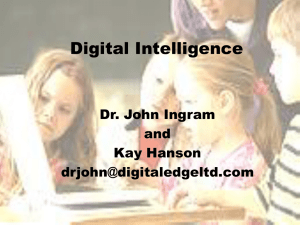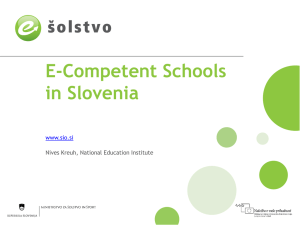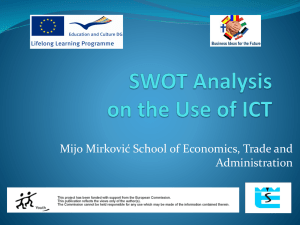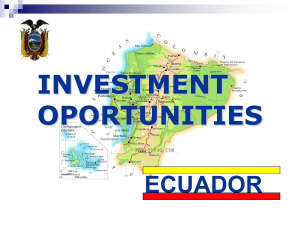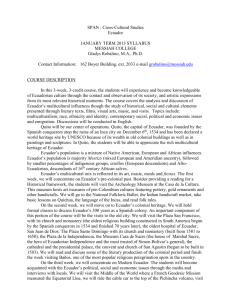Presentación de PowerPoint - Ministerio de Telecomunicaciones
advertisement
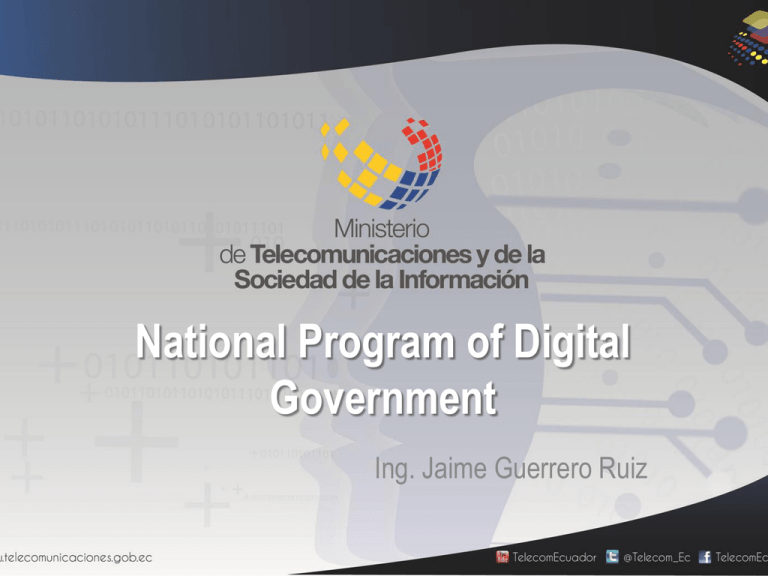
National Program of Digital Government Ing. Jaime Guerrero Ruiz INTRODUCTION Ecuador Population Economy Politics www.mintel.gob.ec • Ecuador has a population of 15’584.417 inhabitants. • 62,77% of the population lives in urban areas, while 37.23% lives in rural areas. • The nation´s GDP in 2011 was $67,002,768,302 • The main exports include oil, bananas, cacao, tuna fish, and coffee. • The Republic of Ecuador is governed by a democratically elected President, Rafael Correa, who serves a 4-year term. • The current Constitution was written in 2008. ORGANIZATION Ministerio de Telecomunicaciones y de la Sociedad de la Información – MINTEL • MINTEL was created on August 13th 2009 as the leading public Institution for the Telecommunications sector in Ecuador. • Priority topics / sectors include connectivity, digital inclusion, e-government, telemedicine, ICT support in education, digital cities, small businesses, technological innovation and digital television. • MINTEL seeks to enhance the efficiency and productivity of the public and private sectors through the proper adoption of ICT in government and small businesses. ORGANIZATION MOBILE CLASSROOMS • The main objective of this organization is to ensure that all Ecuadorian citizens have equal access to ICT and the Information Society. • In that respect, MINTEL has worked to increase the access and use of ICT in Ecuador through investment in infrastructure, ICT community centers, and computer literacy programs. COMMUNITY ACCESS CENTER CONNECTIVITY FOR THE ENTIRE NATION 2006 2012 INTERNET INFRASTRUCTURE INCREASE: • The Ecuadorian growth rate in the use of Internet is the fastest in the region with a CAGR of 38.77% • 30.898,68 Km of Fiber Optic Infrastructure Source: Consultancy Dr. Raul Katz INTERNET USERS Ecuador shows an advanced situation of INTERNET use in the region 2006 JUNE 2012 66.4 59.7*59.5 58.6 55.9 Average: 47.7 45.6 34.5 41 36.5 29.4 28.2 30 20.9 20.7 23.90 Average: 18.6 15.3 15.2 8.0 6.1 6.0 2006 2012 Chile Uruguay Brazil Argentina Argentina Ecuador Colombia Chile Perú Colombia Venezuela Paraguay Uruguay Brazil Venezuela Perú Ecuador Bolívia Bolívia Paraguay Source: ITU, CRC, ASEP, ATT, ANATEL, CNC, SUBTEL, CONATEL, OSIPTEL, URSEC, CONATEL Venezuela * By December 2012 FIXED AND MOBILE PHONES Fixed and mobile subscriptions (per 100 inhabitants ) 20,000,000 140.00 18,000,000 113.50 16,000,000 100.98 14,000,000 115.04 120.00 103.08 100.00 93.53 83.61 12,000,000 80.00 72.94 10,000,000 8,000,000 6,000,000 4,000,000 2,000,000 - 63.28 60.00 Fixed phones penetration greater than mobile phones 10.61 47.27 40.00 27.21 18.67 20.00 12.33 11.18 11.98 12.30 12.81 13.19 13.38 13.77 14.31 14.35 14.97 15.27 15.42 6.88 2001 2002 2003 2004 2005 2006 2007 2008 2009 2010 2011 2012 Mar-13 TELEF. MOVIL TELEF. FIJA Source: Secretaría Nacional de Telecomunicaciones (SENATEL) DENSIDAD TM % DENSIDAD TF % INTERNET SUBSCRIPTIONS Fixed and Mobile INTERNET subscriptions (per 100 inhabitants ) 4,000,000 30.00 3,500,000 25.00 22.60 21.92 3,000,000 20.00 2,500,000 2,000,000 15.00 10.25 1,500,000 9.13 Increase of Mobile INTERNET 1,000,000 10.00 5.77 6.04 4.33 5.00 3.35 500,000 0.69 - 0.80 - 0.84 - 0.92 - 2001 2002 2003 2004 1.04 2005 2.03 2.38 - - - 2006 2007 2008 1.55 - AB. INTERNET FIJO AB. INTERNET MOVIL Source: Secretaría Nacional de Telecomunicaciones (SENATEL) 1.85 1.52 2009 DENSIDAD BAF% 2010 2011 DENSIDAD BAM% 2012 Mar-13 INTERNET MARKET SHARE FIXED ACCESS CNT SURATEL ECUADORTELECOM ETAPA MOBILE ACCESS TELCONET OTROS CLARO [CONECEL S.A.] MOVISTAR [OTECEL S.A.] CNT EP (Ex Alegro) 5% 5% 0% 13% 12% 40% 54% 55% 16% Despite the dominance of one provider, there are other providers that participate in the market. Source: Secretaría Nacional de Telecomunicaciones (SENATEL) The market is dominated by 2 providers. NETWORK READINESS INDEX NRI - Ecuador 2010-2013 RANKING - Ecuador 2010-2013 114 3.6 3.5 23 POSITIONS 108 96 3.3 91 3.0 2010 2011 2012 2013 2010 2011 2012 2013 4.59 4.16 NRI – Latin America 2.93 125 3.91 3.32 3.33 3.37 3.39 3.42 109 108 104 103 102 3.47 99 3.97 3.6 3.01 119 Source: World Economic Forum - The Global Information Technology Report 2013 91 66 60 52 34 144 countries 7 top value ICT DEVELOPMENT INDEX RANKING - Ecuador 2020-2011 IDI - ECUADOR 2002-2011 4.31 3.41 2.73 5 87 3.68 85 85 POSITIONS SINCE 2008 85 2.95 82 1.97 2002 2007 2008 2010 2011 2002 2012 2007 2008 2010 2011 5 5.01 IDI Latin America 2011 4.72 4.31 3.68 3.57 3.14 3.13 1252.44 119 113 2.72 107 109 108 98 3.93 3.92 104 97 103 86 Source: ITU – Measuring the Information Society 2011 * SENATEL 2012 102 82 99 77 91 76 66 60 60 52 56 34 55 155 países 10 valor máximo STRATEGIES • Increasing the accessibility of ICT by families through service cost reductions, readiness programs, and community access centers. o Mobile Classrooms o Community access centers • Increasing the demand of ICT through the introduction of e-services to serve the needs of citizens. o o o o • Implementation of “Digital Cities” pilot programs. Implementation of e-government at the city-level. Promoting use of ICT in businesses. Encouraging growth of e-commerce. Monitoring the growth of the Information Society in Ecuador o Observatory of ICT and Information Society www.mintel.gob.ec PROGRAMS AND PROJECTS C1: Citizen Participation Websites NATIONAL PROGRAM OF DIGITAL GOVERNMENT C2: Emblematic projects of eservices implementation. C3: Design and Implementation o f the ICT Observatory. • E-government platform for municipalities services. • Management of internal processes for the local administration. • Platform of urban interoperability. • Emblematic projects selection. • Development of at least 2 strategic projects of e-services for citizens . • Baseline development of Ecuadorian ICT. • National ICT Observatory implementation. • National Contest of Innovation and Entrepreneurship. SMART CITIES MODEL A Smart City Model use the information and knowledge to attend the citizen’s necessities in a more efficient way … that are related to the strategic objectives of the community • The Smart City Model aims to improve: • Quality of life of citizens • Participation in local administration • Conditions for environmental sustainability • Efficiency of public services • Energy consumption saving SMART CITIES MODEL The Smart City Model operates as neuronal network integrating all the elements of the city´s ecosystem to achieve a greater quality and efficiency Administration Tourist Card Tarjeta ciudadana Tourist Card Válido todos los días de la semana Nombre Apellido Válido todos los días de la semana. Personal e intransferible 72h Security People Citizen Card Others Medium and Big Enterprises Mobility Gijón Smart Identi City ty Services Urbanism Electric grid Urban waste Small Enterprise Enterprise Business Physical Environment Renewable energies Foreign Enterprises Energy consumption Main characteristics of the network: integrated, interconnected and dynamic SMART CITIES MODEL The implementation of the Smart City Model requires a process change with a triple focus: technology, organization and operation model. Organization Technology Technological scalable model that integrates the city information systems and allows good coordination and efficiency. Cross organization facilitates the flow of information between departments Operation Model Variables models integrating focused on efficiency and quality of service SMART CITIES MODEL • The Smart City Model creates a digital ecosystem, where the main urban services are integrated Citizens XXX Business • It helps to increase the competitiveness of the city, by improving the efficiency of the services offered to the citizens • It offers a way to increase the “intellectual and social capital” Security Source: DFISSI DIGITAL TERRITORY METHODOLOGY Methodology of Digital Territories applied to small and medium cities Current Analysis City analysis (needs and capacities) Strategic Objectives Definition Methodology Strategy Methodology Strategy METHODOLOGY FOR SMART CITIES’ IMPLEMENTATION Fuente: DFISSI DIGITAL TERRITORY METHODOLOGY Components and Objectives Education E-Government •Participation of ICT in the educational process •Development of educational content •Training of students, faculty and staff •Management of internal and external services • Scan internal service • Scan external service • Disclosure and availability of information Health Digital Enlistment • Integration of the health system • Development of models of prevention • Internal service management • Universal access to ICT • Appropriation of ICTs for everyday use Security Employment • Coordination of safety and emergency services • Communication and participation • Facilitating business relationship • Content development for workers • Generating technological poles Energy saving and carbon emission reduction Fuente: DFISSI RECENT ACHIEVEMENTS Thank you www.telecomunicaciones.gob.ec




